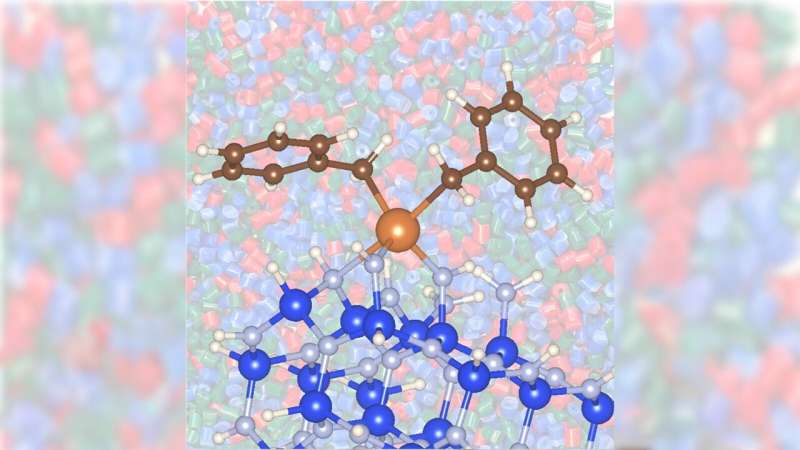This article has been reviewed according to Science X's editorial process and policies. Editors have highlighted the following attributes while ensuring the content's credibility:
fact-checked
peer-reviewed publication
trusted source
proofread
Researchers discover faster, more energy-efficient way to manufacture industrially important propylene

Polypropylene is a common type of plastic found in many essential products used today, such as food containers and medical devices. Because polypropylene is so popular, demand is surging for a chemical used to make it. That chemical, propylene, can be produced from propane. Propane is a natural gas commonly used in barbeque grills.
Scientists from the U.S. Department of Energy's (DOE) Argonne National Laboratory and Ames National Laboratory now report a faster, more energy-efficient way to manufacture propylene than the process currently used. The research is published in the Journal of the American Chemical Society.
Converting propane into propylene typically involves a metal catalyst like chromium or platinum on a support material, such as aluminum oxide or silicon dioxide. The catalyst speeds up the reaction. However, it also necessitates high operating temperatures and energy use.
In a collaborative project, scientists from Argonne and Ames found that zirconium combined with silicon nitride enhances the catalytic conversion of propane gas to propylene. It does so in a way that is faster-reacting and less toxic and uses less energy than other nonprecious metals, like chromium. It is also less expensive than precious metal catalysts like platinum.
This discovery also reveals a way to reduce the temperature of the catalytic process. In turn, this reduces the amount of carbon dioxide released. Carbon dioxide accounts for almost 80% of greenhouse gas emissions in the United States.
Additionally, this research gives a glimpse into the reactivity achievable with other low-cost metals in the catalytic conversion of propane into propylene.
For some time, Argonne chemists David Kaphan and Max Delferro have been systematically studying how nontraditional surfaces influence and promote catalysis. As lead researchers on this study, they wanted to understand how a nontraditional metal catalyst on a nontraditional type of support compares with traditionally used materials during the catalytic conversion of propane.
Catalyst support materials typically have high surface areas and help to distribute catalysts. They can also play an important role in promoting catalysis, as shown in this study.
The research team found that a zirconium catalyst on a silicon nitride support yielded significantly more active catalysis for the conversion of propane into propylene. Conversely, this was not the case with the silica support.
They also found that the silicon nitride support enabled catalysis in a way that is faster and more energy-efficient than with traditional metals on silica. As a catalyst support, silicon nitride can enhance chemical reactions on the surface of metals relative to more traditionally used oxides.
The scientists achieved catalytic conversion of propane at a temperature of 842 degrees F. This is slightly lower than the 1,022 degrees F typically required for catalysis using traditional materials. Furthermore, when run at the same temperature as traditional catalysts for this transformation, the reaction rates were significantly faster than similar materials with oxide supports.
This discovery also offers proof that this concept can be generalized for other important reactions.
"This provides a window into nitride-supported metal reactivity. We see promise with the use of other transition metals where we can leverage this difference in the local environment of the nitride surface to enhance catalysis," Kaphan said.
This research benefited from Argonne's Advanced Photon Source (APS), a DOE Office of Science user facility. At beamline 10-BM, researchers used X-ray absorption spectroscopy to understand how the zirconium catalyst interaction with the nitride material differs from the oxide material.
Argonne researchers also collaborated with Frédéric Perras, a scientist at Ames National Laboratory, to gain a better understanding of the structure of the zirconium/silicon nitride catalyst. He used a dynamic nuclear polarization-enhanced nuclear magnetic resonance technique to analyze how silicon nitride reacts with metal sites.
"The composition on the surface of silicon nitride is largely unknown, which is what I found most exciting about this work," said Perras, who is also an adjunct associate professor at Iowa State University.
The combination of material characterization techniques available at Argonne and Ames and the expertise of the people who worked on this paper is what contributed to the success of this experiment, according to Delferro.
"One person cannot do everything. This is really a team effort, and everyone brought their expertise to the table to achieve this goal," he said.
In addition to Delferro, Kaphan and Perras, research authors include Joshua DeMuth, Yu Lim Kim, Jacklyn Hall, Zoha Syed, Kaixi Deng, Magali Ferrandon, A. Jeremy Kropf and Liu Cong.
More information: Joshua C. DeMuth et al, Silicon Nitride Surface Enabled Propane Dehydrogenation Catalyzed by Supported Organozirconium, Journal of the American Chemical Society (2024). DOI: 10.1021/jacs.4c02776
Journal information: Journal of the American Chemical Society
Provided by Argonne National Laboratory



















